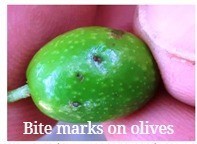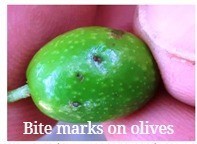kashrut olives
Question
Am I allowed to pick and eat olives from my tree?
Answer

The olive fruit fly, Bactrocera oleae, is a serious pest that affects olive cultivation. The fly thrives primarily in warm and humid areas, and is prevalent in the Middle East and South Africa.
The fly punctures the olive skin and deposits one egg inside (sometimes bites are without egg deposits). Only one larva develops in each olive, even if there are several bite marks on the olive. The larva (white) tunnels into the fruit, and before turning into a cocoon, it tunnels its way towards the surface layer. After the adult fly emerges from the olive, it leaves a hole and the olive appears dark, rotten, and lopsided—not elliptical as usual.
 (Photo: Papirus, the Israeli Gardening Portal)
(Photo: Papirus, the Israeli Gardening Portal)
Dark botches or rotten areas can attest to the presence of a worm or cocoon in the fruit and we need to open and check it. However, the fly might have hatched and exited the olive or the olive might be physically damaged. If the olive is full inside, it is insect-free. Holes in the olive attest to the presence of an insect.
Yet, the larva might be at the beginning stage of development, when large dark spots are not present. So we need to check for bite marks, which look like small dark spots. If bite marks are present, open the fruit to check for larva. For people who do not know what to look for, bite marks might be hard to identify.
If olives appear whole and there are no dark spots, rotten areas, or bite marks, they can be eaten (note: scale insects sometimes stick to olive skin and should be removed).
In commercial orchards in Israel, most farmers spray against the olive fruit fly. Most imported olives are from Egypt, Jordan, and Turkey (from the Institute for the Mitzvot of Eretz Yisrael).
Infestation is highly possible in private gardens and untreated orchards; nets and fly traps can help reduce the presence of these flies.
